It’s been over a week since our last entry in the Traffic Soyboys series. I promised to deboonk the “suburbs are Ponzi schemes,” nonsense, and I’ve been putting it off. The problem is that the claim is supported by such little evidence that, like many Traffic Troon claims, it takes far more effort to deboonk than it did for them to make it in the first place.
Imagine someone saying “we should just use rockets to travel, because they’re really fast and, once you’re in orbit, they don’t use any fuel.” It takes a lot longer than one sentence to explain why they’re a moron who doesn’t know what they’re talking about. By the time you’ve done that they’ve moved on to their next Ideas Guy societal re-engineering project that will be also quietly forgotten. They have more in common with Elon Musk than they’d like to admit.
For the record the video above is mediocre at best. They cope by claiming the Hyperloop Vaporware could be used to transport freight. This makes no sense, since freight is usually not time-sensitive. That’s why trains are so well suited for freight, since they have good throughput and time is not a factor. If time is a factor, just use the things which are like the hyperloop, but better in every way, and actually exist.

It’s easy to sit back now, a decade after Elon “dumbfuck” Musk proposed his “not that hard,” garbage Hyperloop idea and point out that we literally have nothing to show for it. It was a lot harder back in the day painstakingly explaining all the ways in which this idea was stupid and unworkable.
Contrast the above video, made six years ago, with the below video, made just one year ago. Above is a long technical breakdown of the problems with the Hyperloop. Below is a well earned gloating victory lap for Thunderf00t after Virgin fired half of their staff.
The general claim from Strong Towns, and the Urbanite Bugcreatures, is that suburbs are totally unsustainable Ponzi schemes, and have been since WW2. At this point, you would expect we could skip straight to the victory lap stage, since the epidemic of suburbs going bankrupt should have clearly shown this at some point in the past 70 years.
Not so fast, say the traffic troons, because something something subsidies and something something illegal to declare bankruptcy and something something constant growth. You see, suburbs are going bankrupt, but it hasn’t happened yet for reasons that only hyperintelligent geniuses can figure out. You’re just too dumb to get that our totally unquantified Just So LOLbertarian-style theorycrafting is Ackshually still factually correct because Vague_Reasoning.
Where can I look for some evidence of the suburban “ponzi scheme” idea?
I’m pretty passionate about building walkable neighborhoods. A consistent theme in NJB videos (and other urbanist videos) is that sprawling suburban infrastructure and massive highways cannot be financially supported by the type of development that they support. The hypothesis is that eventually suburbs will go bankrupt unless they are bailed out by the non-driving population. I’m a little confused about how that works since I think most Americans live in low-density car-dependent developments, including most the of the wealthiest Americans, so I don’t understand how a less wealthy urban minority population is able to bail out the wealthier suburban majority. Where can I look for some examples of this “bankrupt suburban town” phenomenon occurring? Please don’t say cities like Detroit because “white-flight” is a different phenomenon.
He gets a response from user HOU_Civil_Econ.
The only actual examples I’ve seen, come largely from Strong Towns Cherry picking a few shithole dying rural towns who get grants from the feds for infrastructure they can’t maintain, mostly water/sewer treatment plants. This is not the evidence against suburbia Mr. Marohn seems to think it is.
This misrepresentation of what is going on is directly harmful to the larger argument because, just as you have figured out, it implies there should be bankrupt suburbs scattered everywhere, and there just aren’t.
Of course he got massively downvoted for sprinkling in some tiny tidbits of truth to the reality denying Urbanite community. Jason “not just bikes” Slaughter felt compelled to respond to him directly. I’ll transcribe below.

Strong Towns and Urban3 have analyzed dozens of cities, and have been specifically brought in by several municipalities to help them with their finances.

We talked about that before. In short, their “analysis” “proved” that empty lots in downtown areas are more “economically productive,” because they pay higher property taxes.
Dismissing these as “shithole dying rural towns” is incredibly misleading, especially when the only time the shit hits the fan is when the population is shrinking, and the Growth Ponzi Scheme can’t cover up the deficit. If they weren’t shrinking, you wouldn’t notice the problem.
Besides, Stockton (CA), Detroit (MI), and Jefferson County (AL) have gone bankrupt. None of these are “shithole” or “rural”.

Jaime can you bring up the OP please.
Where can I look for some examples of this “bankrupt suburban town” phenomenon occurring? Please don’t say cities like Detroit because “white-flight” is a different phenomenon.
Thanks Jaime. Also, Stockton and Detroit aren’t even suburbs. Jefferson County includes suburbs as well as Birmingham, Alabama. They went bankrupt due to corruption.
In the 1990s, the county authorized and financed a massive overhaul of the county-owned sewer system, beginning in 1996. Sewerage and water rates had increased more than 300% in the 15 years before 2011, causing severe problems for the poor in Birmingham and the county.
Costs for the project increased due to problems in the financial area. In addition, county officials, encouraged by bribes by financial services companies, made a series of risky bond-swap agreements. Two extremely controversial undertakings by county officials in the 2000s resulted in the county having debt of $4 billion. The county eventually declared bankruptcy in 2011. It was the largest municipal bankruptcy in United States history at that time. Both the sewer project and its financing were scrutinized by federal prosecutors. By 2011, “six of Jefferson County’s former commissioners had been found guilty of corruption for accepting the bribes, along with 15 other officials.”
The controversial interest rate swaps, initiated in 2002 and 2003 by former Commission President Larry Langford (removed in 2011 as the mayor of Birmingham after his conviction at trial), were intended to lower interest payments. But they had the opposite effect, increasing the county’s indebtedness to the point that it had to declare bankruptcy. The bond swaps were the focus of an investigation by the United States Securities and Exchange Commission.[11]
Turns out that having your city leadership straight up steal taxpayer money is bad for finances. Who knew?

Former mayor Larry Langford
A county with a 40% Black population had municipal leadership engage in some extreme corruption with finance corporations, and as a result they declared bankruptcy. Boy, we sure showed those suburbanites. Imagine not believing that all suburbs are ponzi schemes because city officials and finance institutions raped the (White) taxpayers in one particular county.
But the real reason you’re not seeing so many bankrupt suburbs is because they’re literally not legally allowed to go bankrupt.
You hear that you stupid CarBRaInS? Suburbs are literally not allowed to go bankrupt. It’s just not possible. It’s illegal. It never happens. He’s got a link that proves it. Let’s click on that, kick back our feet, and enjoy the holocausting of the coping suburbanite caRbRAiNs as they see the undeniable truth that cities, towns, and counties cannot legally file for bankruptcy.

Jaime can we pull up that NotJustBikes quote again please?
But the real reason you’re not seeing so many bankrupt suburbs is because they’re literally not legally allowed to go bankrupt.
I’ve expressed my amazement at how easily deboonked the claims of the Traffic Soyboys are, and this may be a new low. His proof that suburbs are subsidized, but that we don’t see this because municipalities are legally prevented from going bankrupt, is to link to a study where the first thing they tell you is that almost 30 municipalities have indeed gone bankrupt since 2001.
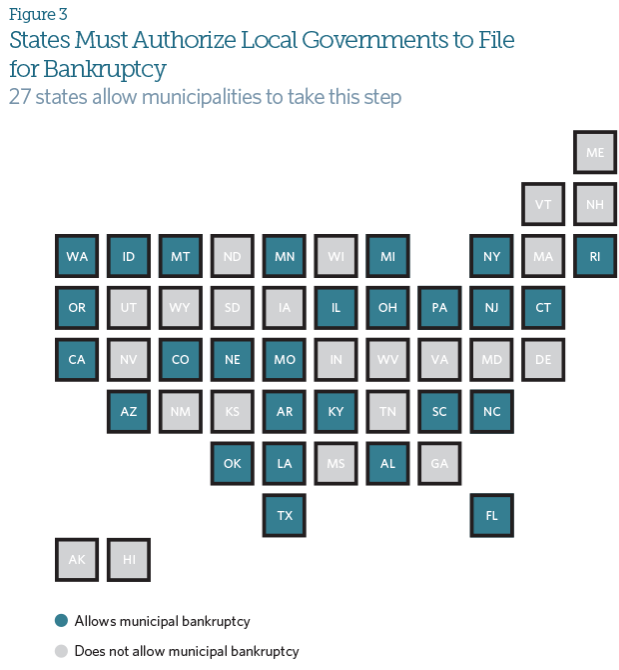
In fairness, they do also include this graphic, which shows that almost half of all states do not allow municipalities to declare bankruptcy. You would think that two things would be happening. First, the 27 states that allow municipalities to go bankrupt would have suburbs constantly declaring bankruptcy. Second, the other 23 states should see suburbs constantly decaying due to a lack of funds. After all, if you’re deeply in debt and you can’t get out, you need to cut back somewhere, right?
But the ready made answer they have is that suburbs are secretly subsidized in vague, unquantified ways. All of this references Strong Towns, who themselves make a bunch of vague, unquantified assertations without evidence. It’s incredibly tedious to debunk incoherent claims, so I decided that I’m not going to do it.

Calm down. I meant that I’m not going to do it today, but will in the near future. The traffic soyboys work has been put on the backburner recently, but this is the beginning of the blitz towards the finish line.
However, I realized that it would be best to start with a takedown of the idiots at Strong Towns. I want everyone to understand the total lack of intellectual and factual rigour that underpins the entire Urbanite e-Movement. There’s no better place to start than their One Weird Trick to Magically Not Understand Economics Like Even a Little Bit.
A recent study on curbside dining in Toronto found that there are loads of financial possibilities waiting in empty parking spaces.

You just know this is going to be retarded.
During the pandemic, Toronto, like many cities, began allowing some on-street parking spaces to be used as patios by local businesses. As reported by The Globe and Mail, residents spent a total of $181 million at curbside patios within 13 weeks of summer in 2021. If those spaces had remained dedicated to parking, only $3.7 million would have been reaped during the same time period. In other words, curbside patios produced 49 times more revenue than what would have been earned from parking fees.

It’s even worse than I thought. And that’s not just because their “proof” of the “49 times more revenue” number is a Google Doc that gives you this result when you click on it.

I guess we’ll just have to use our imaginations.
I’ll explain later, but as an exercise to the reader, try to find the monstrously dumb snuck-in premise they’re using this time.
“This is an example of how productive a place can be when we don’t fixate on parking,” said Strong Towns Senior Editor Daniel Herriges. “Public space in a lively urban area is a tremendously important and scarce resource, and parking is often just about the least valuable thing we can do with it. Any city can do this math.”
Infrastructure is less profitable than the things that it enables, so you shouldn’t have infrastructure. It’s just math. Only stupid people don’t get it.

Worlds’ No 1 Strong Towns fan
While we’re at it, let’s rip out the sanitation facilities. Those actually lose money, so we should just have open sewage everywhere. In their place we can build organic dildo shops. Can’t believe carbrains haven’t done the math on this one.
Parking spaces are abundant in North America. It’s common, even in dense urban areas like the core of Toronto, to see generous amounts of both private parking and public curbside parking along nearly every street. Too often, said Herriges, local governments make no attempt to account for the opportunity costs.

Can’t believe these cARbRAiNs want toilets and kitchens in restaurants. Tables are where people pay for things, and therefore where the money is made. If we had a restaurant that was only tables, we now have only the money making things. If half your space is taken up by the kitchen, storage, and bathrooms, then just delete all that and make more tables. Viola, profits doubled.
Do the math retard. Opportunity costs are a thing, moron. Car infrastructure is unsustainable, Chud.
“In most cities, parking is kind of the assumed, default use of the curb lane on city streets,” Herriges said. “It’s often offered for free—even in places like New York where demand ought to be sky high—or it’s underpriced relative to what drivers would actually be willing to pay to park. This amounts to an enormous subsidy to North American drivers, with the costs paid by society in terms of lost productivity and greater distances between the places we actually want to be.”
“Free” public parking actually costs the public a hefty amount. It’s not just the cost of the asphalt and the maintenance. The Toronto study dramatically illustrates another cost of parking: all the activity that can’t happen in that wasted space.
Below we see the example they give in this piece of “curbside dining.” Take a minute and think about how the customers arrived at the locale. And please note that all the existing parking spots appear to be filled.
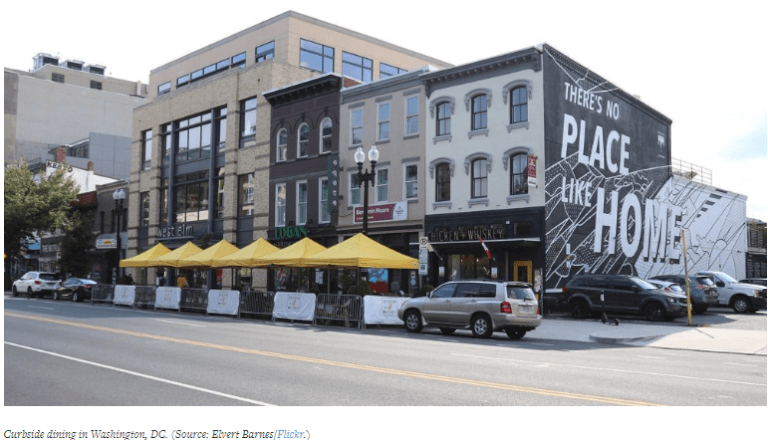
If you answered “they drove there in their cars,” give yourself a big fat X. I can’t believe how wrong you are. Stupid CaRBraIn.

They got there by simply spawning into the gameserver. If we deleted all the parking spots, the customers would still be there. Cars have no justification for their existence because public transit exists and there’s no such thing as the partial trip problem, or personalized transportation needs.
Stupid people think that bathrooms and kitchens are essential infrastructure that enable the restaurants to function. These same stupid people also think that parking spots are essential transportation infrastructure that enable the customers and workers to be there in the first place. But hyperintelligent geniuses understand that there’s no such thing as infrastructure that enables other productive enterprises. Except for train infrastructure, which is good even if it costs $100 billion for a train to nowhere.
Back to Strong Towns.
Trading a small amount of street parking for curbside dining has been an obvious win for Toronto—and there are many other similar wins that cities of all sizes could pursue.
Remember how, in the previous piece, they “found out” that downtown areas pay more property taxes per acre – including empty lots – and then reframed this as “people who live downtown are subsidizing rich suburbanites”?
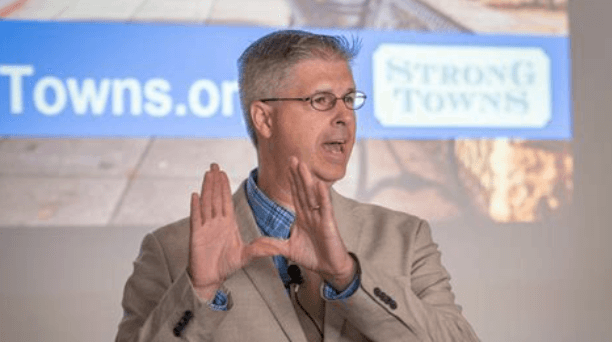
This time they figured out that the parts of a business that create profit make more money than the parts of a business that are essential infrastructure. Perhaps next they can revolutionize department stores. It turns out that that the physical location where the cashiers work makes more money than the mini-warehouse they store the goods in out back. You know what that means, right?

Delete the warehouse and storage rooms and put cashiers in there. Then keep going and delete all the aisles that hold the goods as well. Those don’t make money, only the cashiers make money.
In 2020, Edmonton became the first Canadian city to remove minimum parking requirements on developments. These rules, which force developers to include set amounts of parking, are based in pseudo-science rather than rigorous standards, said academic Donald Shoup, author of the seminal book The High Cost of Free Parking.
I covered this amazing scientist before. His argument was that there are something like 8 parking spots for every car in America. He then assumed that this was bad for absolutely no reason. Then he claims that parking infrastructure can simply be turned into low income housing. Impeccable logic.
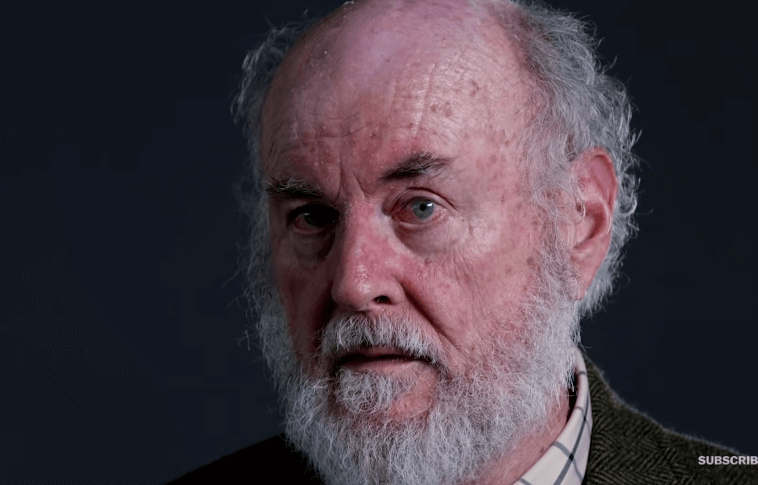
Don Shoup
Why stop at car parking spots? Why not extend this to butt parking spots? Get a load of all the butt infrastructure in this fancy home below! I think it’s time to insinuate that urban criminals of colour are subsidizing these suburban HuWhyte People and their butt-centric interior spaces.

It really is amazing how much of our precious real estate is taken up by the Butt Lobby’s never ending crusade to get as many butt parking spots into our homes as possible. And they don’t just stop at our homes. Precious downtown real estate is taken up by butt infrastructure that simply sits there, unused the majority of the time.
 We only need one seat, also known as a butt parking spot, for every butt in America. We also only need one car parking spot for every car. Anyone who thinks otherwise is a pseudo-intellectual who isn’t rigourous, unlike Don Shoup. We can simply convert the excess butt parking spot infrastructure into low income housing for queer trans youth.
We only need one seat, also known as a butt parking spot, for every butt in America. We also only need one car parking spot for every car. Anyone who thinks otherwise is a pseudo-intellectual who isn’t rigourous, unlike Don Shoup. We can simply convert the excess butt parking spot infrastructure into low income housing for queer trans youth.
More than a dozen Canadian cities have followed suit, removing parking minimums in at least part of their area, according to research by the advocacy group Strong Towns.
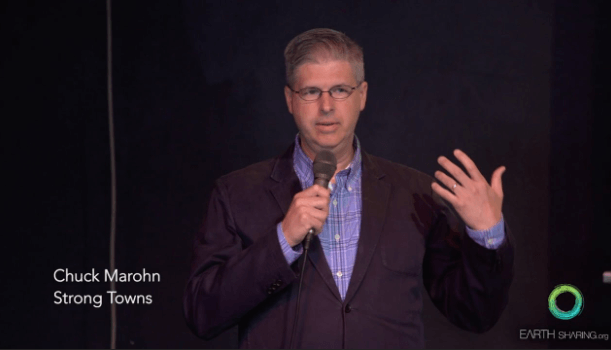
Every day I pray that these snarky midwits have no affect upon the world outside of their little e-enclaves. Every day I become increasingly nervous that this is not the case.
I hope that you already understand just how dumb the argument they’re making here is. However, just in case you haven’t figured out the bizarre bait and switch, here’s a story from November 2020 about a Toronto restaurant owner. It turns out there were reasons why outside space was at a premium from 2020-2022 in Toronto.
Adam Skelly, 33, declared on social media Monday night that he would open his BBQ restaurant in Etobocike to in-person dining despite provincial lockdown orders for Toronto and Peel Region.
He opened to serve customers on Tuesday before being ordered to close by Toronto Public Health. Despite the order, he returned to serve customers on Wednesday, resulting in in non-criminal charges for Skelly and the corporation that owns the restaurant.

He ended up shuttering all of his restaurants. Not an uncommon story for Toronto restaurants, considering that they had to go under extreme Covid-19 lockdown restrictions.
BBC:
Toronto restaurants have been closed to diners for over 360 days since the start of the pandemic, giving the city one of the longest indoor-dining bans in the world. Why?
For over a year, Toronto restaurants were totally shut down to in-person dining. Later they were shut down to everyone without vaccination, but still had restrictive rules on seating. The one saving grace? They were allowed to serve customers outside at the patios.
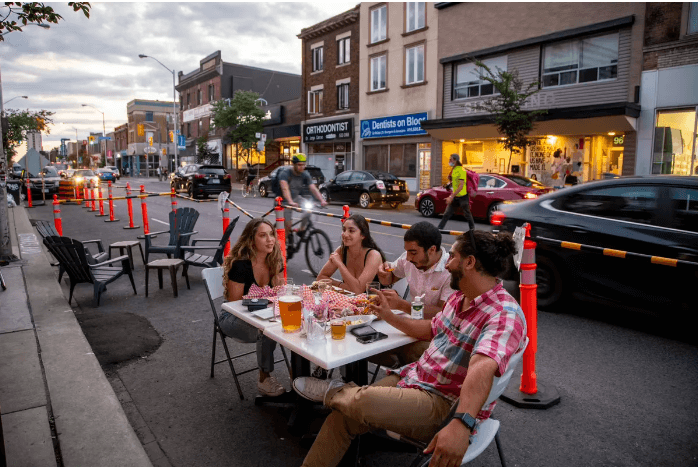
There is no mystery as to why these Toronto restaurants would normally prefer the parking. Without Covid-19 they have indoor spaces that they want to fill with diners who need to get there using their cars. During Covid-19 they were not allowed to use any of their indoor dining spaces, but the city let them convert parking spots to tables which made sense since they suddenly had literally no seating areas for people to eat there.
Now that Covid-19 is over, the parking spaces have been converted back to parking spaces, because of course they have. They need them for parking.
Outdoor patios were a rare bright spot in Toronto in the depths of the pandemic, but, now, as the city looks to make its popular CaféTO program permanent, it will come with new costs and regulations for restaurants, leading some to wonder if it’s worth the investment.
Robert Lundy, owner of Shakey’s Bar and Grill on Bloor Street West, was able to almost double his seating space with a curb lane patio and hired more staff, keeping his business and the community afloat during tough months.
“It definitely brings the city alive,” he said. “But I don’t think it is going to survive after this season … I can’t spend $13,000 before I even start.”
The city took down 100 patio spaces last year that were blocked off but not being used.
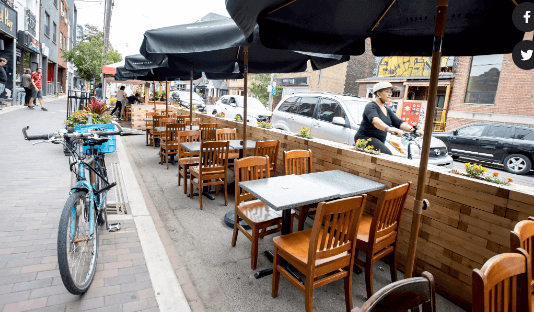
It would be natural to assume that the City of Toronto Government is merely being greedy and killing the program unnecessarily. This is not the case. They were subsidizing the curbside patio program the entire time, and in fact still are.
The CafeTO program was introduced in 2020 to allow restaurants and bars to expand their outdoor spaces amid lockdowns that led to restrictions on indoor dining. Over the life of the program, the City has provided $20 million in financial support.
Two grants for small businesses and Business Improvement Areas (BIAs) will continue in 2023, including the CafeTO Improvement Program, which will match 50 per cent of the cost of eligible patio space improvements up to a maximum of $7,500.
Even at half-subsidized costs it’s hard for a restaurant owner to justify participating in this program when there is such little demand. Outdoor dining can be extremely nice, especially in summertime. Everyone already knows this, which is why restaurants already have regular old-fashioned patios. Now that these restaurants have gotten their indoor seating legally returned to them, almost all of them have dropped out of their curbside dining program. This is especially true if the curbside patio seats are unused, while the parking spots they take up are in great demand. And as anyone who has been to Toronto will tell you, parking is in great demand.
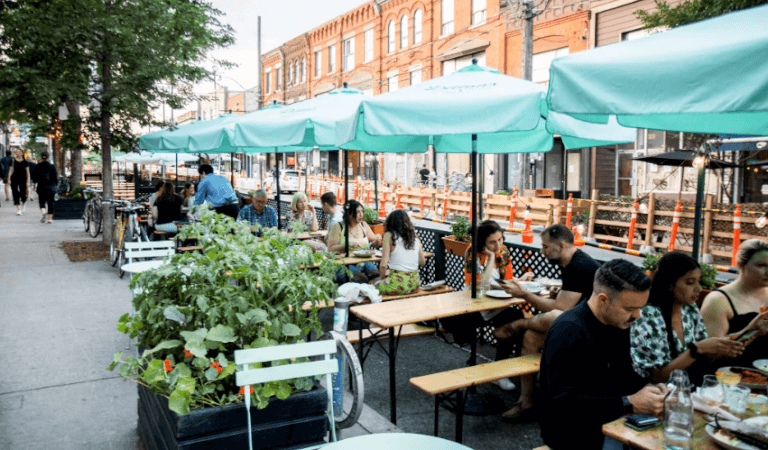
Curbside patios, during Covid-19.
The people who actually run these businesses want their parking, but the Urbanite Antifas know better. The argument they use is that the physical location where the patios existed brought in more revenue than the parking spots during Covid-19 when indoor seating was totally banned. Not that the entire restaurants were better off, just that the very specific spots where street parking used to be, and has now returned, made more revenue than pay parking.
To their 93 IQ minds, this has permanently proved that parking spots == bad and curbside patios == good. Therefore, the people who actually own the restaurants are dumb dumbs for wanting the parking. How could someone be so foolish as to try maximizing the profits of their business, instead of the profits of the physical area where the parking is located. Don’t they know that the true measure of restaurant success is how much revenue is generated in a very specific location out front.
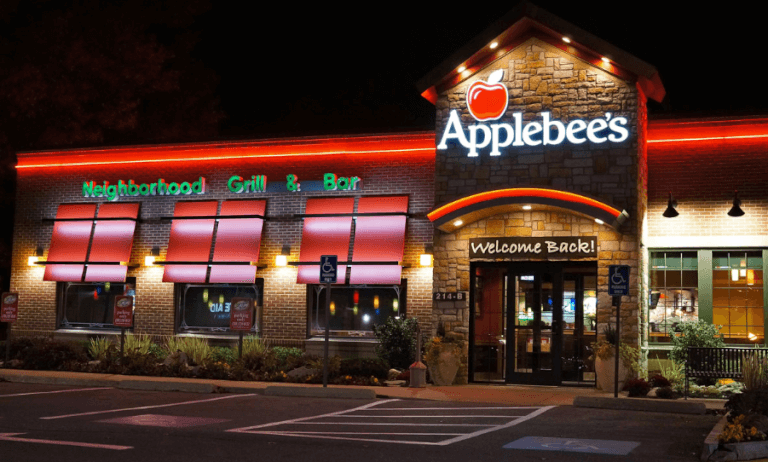
Above we see an Applebees. To our horror, there is no one eating out front. They don’t even have paid parking, so there is zero revenue coming in from the ten square foot area in front of the restaurant. Because we have arbitrarily decided for absolutely no reason that it doesn’t matter how profitable the inside of the restaurant is we can expect this location to be out of business in no time.
I am shocked at the incompetent design. How could anyone think that parking spots which don’t even generate revenue could compete against tables for customers which do generate revenue? One generates revenue and therefore == good. The other just helps the customers get there in the first place and therefore provides no value.

My face when I see the parking lot has not been turned into tables.
Strong Towns’ curbside parking lots claim gets stupider the longer you think about it. Paid parking spots can be made profitable more easily than the restaurants, since they have lower operating costs. The spot only needs to justify its worth in property taxes, while the restaurant must pay for food costs, salaries, etcetera. Even after accepting the absurd premise that you can compare profits from infrastructure to profits from service they didn’t even do it right, since they compared revenue to revenue, not profits to profits.
Also, street parking is typically owned by the city, so the City of Toronto Government is subsidizing this even more than immediately apparent. I could go on, but if I noted every single nonsense argument these people make this series would be finished sometime in my 80s. Eventually we have to stop after getting the juiciest bits.

The point is that these people are really dumb, and this isn’t Adam Something, Not Just Bikes, or any of the YouTube dipshits. This is the genius insight of the Strong Towns bunch. These are the titanic minds that we’re dealing with, a bunch of snarky midwits who are so obviously wrong on basic issues that it’s genuinely disorienting when analyzing their claims. Much of what they say doesn’t even qualify as wrong, because they have such little understanding of the subject matter that they fundamentally don’t get it.
Keep this in mind when we start into the Suburban Ponzi Scheme. If you ever feel like something they said was really stupid, it’s because it was. If I missed pointing it out it’s probably because the piece was already over 8k words and I had to edit it down to a readable length. Or I simply got swamped in some other nonsense and it squeaked through.



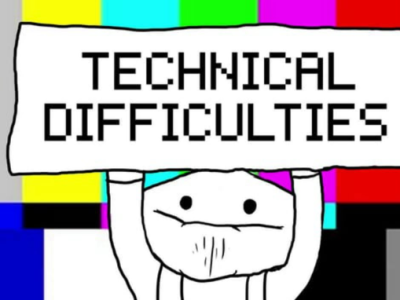








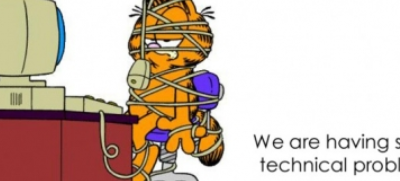
It’s such a common tactic with leftists and jews it even has a name, Brandolini’s Law:
“The amount of energy needed to refute bullshit is an order of magnitude larger than is needed to produce it”.
Great find. I’ll be using that going forwards.